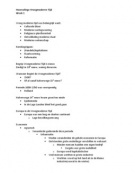Hoorcolleges The Story of Art
Hoorcollege 1:
Sandro botticelli, The birth of Venus, c. 1485
Antique – Medieval – Early Modern – Modern
Wifredo Lam, The Jungle, 1943
Pablo Picasso, Les Demoiselles D’Avignon, 1907
,Hoorcollege 2:
The Story of Art: The Dawn of the Renaissance in Italy
The middle ages:
- The life of Christ
- Medieval Iconography = a reference to medieval Catholic iconography
Breaks with Conventions:
- Padua in Italy.
- Scrovegni (or ‘arena’) Chapel, Padua c. 1300.
Annunciation: The angel Gabriel was sent by God
Visitation
Nativity: Birth of Jesus
Adoration of the Magi
Presentation of Christ at the Temple
Flight into Egypt
Massacre of the Innocents
Christ among the Doctors
Baptism of Christ
Marriage at Cana
Raising of Lazarus
Entry into Jerusalem
Expulsion of the Moneychangers from the Temple
,The passion:
Last supper
Washing of feet
The arrest of Christ (Kiss of Judas)
Christ before Caiaphas
Christ mocked
Road to Calvary
Crucifixion
Lamentation (The Mourning of Christ)
Resurrection
Ascension
Giotto, The Adoration of the Magi, Scrovegni Chapel, Padua. 1305–0
Giotto The Lamentation of Christ c. 1304 Padua, Italy: Arena Chapel (or Scrovegni Chapel)
, The Renaissance
- What is the Renaissance? The term Renaissance is often used to refer to a time period
(around 1400-1600). At its core, however, the term refers to an intellectual movement that
began in 14th century Italy.
- Renaissance means rebirth – in this case, the rediscovery and rebirth of the knowledge,
values, and aesthetics of the ancient Greeks and Romans (as understood by 14th-century
Italians).
- Advocates of this movement came to call themselves humanists, a term based on Cicero’s
concept of humanitas, the idea that people are distinguished from animals by language, and
that linguistic communication and the study of texts- in the Renaissance, specifically texts
from antiquity - should be the highest calling. Humanists wanted to access and deeply
understand classical culture in its original, truest forms.
Factors that contributed to the development of the Renaissance:
1. Patronage:
- Lorenzo de Medici (1449-1492) ‘Il Magnifico’
- Grandson of Cosimo de Medici, founder of the Medici bank.
- Passionate patron of the arts, employing writers and visual artists like Leonardo da Vinci,
Donatello, Sandro Botticelli, Domenico Ghirlandaio, Andrea del Verrocchio, and
Michelangelo Buonarroti.
- This secular patronage was a major factor in the continued blooming of Italian art in the later
fifteenth century, especially in Florence.
2. Rise of a Merchant Class
Humanisme:
- Idealisatie van de perfecte mens?
Interest in Perspective:
- Filippo Brunelleschi, 1377-1446
- Is credited with having ‘discovered’ linear perspective. He sought to understand, imitate,
and surpass ancient Roman building practices. His most famous achievement was the dome of
Florence’s cathedral, the largest dome that existed at the time, creating using a double-shelled
structure.
Hoorcollege 1:
Sandro botticelli, The birth of Venus, c. 1485
Antique – Medieval – Early Modern – Modern
Wifredo Lam, The Jungle, 1943
Pablo Picasso, Les Demoiselles D’Avignon, 1907
,Hoorcollege 2:
The Story of Art: The Dawn of the Renaissance in Italy
The middle ages:
- The life of Christ
- Medieval Iconography = a reference to medieval Catholic iconography
Breaks with Conventions:
- Padua in Italy.
- Scrovegni (or ‘arena’) Chapel, Padua c. 1300.
Annunciation: The angel Gabriel was sent by God
Visitation
Nativity: Birth of Jesus
Adoration of the Magi
Presentation of Christ at the Temple
Flight into Egypt
Massacre of the Innocents
Christ among the Doctors
Baptism of Christ
Marriage at Cana
Raising of Lazarus
Entry into Jerusalem
Expulsion of the Moneychangers from the Temple
,The passion:
Last supper
Washing of feet
The arrest of Christ (Kiss of Judas)
Christ before Caiaphas
Christ mocked
Road to Calvary
Crucifixion
Lamentation (The Mourning of Christ)
Resurrection
Ascension
Giotto, The Adoration of the Magi, Scrovegni Chapel, Padua. 1305–0
Giotto The Lamentation of Christ c. 1304 Padua, Italy: Arena Chapel (or Scrovegni Chapel)
, The Renaissance
- What is the Renaissance? The term Renaissance is often used to refer to a time period
(around 1400-1600). At its core, however, the term refers to an intellectual movement that
began in 14th century Italy.
- Renaissance means rebirth – in this case, the rediscovery and rebirth of the knowledge,
values, and aesthetics of the ancient Greeks and Romans (as understood by 14th-century
Italians).
- Advocates of this movement came to call themselves humanists, a term based on Cicero’s
concept of humanitas, the idea that people are distinguished from animals by language, and
that linguistic communication and the study of texts- in the Renaissance, specifically texts
from antiquity - should be the highest calling. Humanists wanted to access and deeply
understand classical culture in its original, truest forms.
Factors that contributed to the development of the Renaissance:
1. Patronage:
- Lorenzo de Medici (1449-1492) ‘Il Magnifico’
- Grandson of Cosimo de Medici, founder of the Medici bank.
- Passionate patron of the arts, employing writers and visual artists like Leonardo da Vinci,
Donatello, Sandro Botticelli, Domenico Ghirlandaio, Andrea del Verrocchio, and
Michelangelo Buonarroti.
- This secular patronage was a major factor in the continued blooming of Italian art in the later
fifteenth century, especially in Florence.
2. Rise of a Merchant Class
Humanisme:
- Idealisatie van de perfecte mens?
Interest in Perspective:
- Filippo Brunelleschi, 1377-1446
- Is credited with having ‘discovered’ linear perspective. He sought to understand, imitate,
and surpass ancient Roman building practices. His most famous achievement was the dome of
Florence’s cathedral, the largest dome that existed at the time, creating using a double-shelled
structure.











